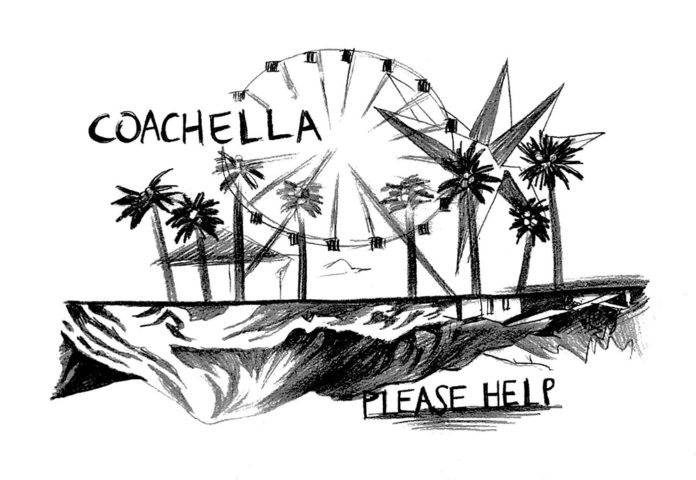It was that time of year in Los Angeles again. Miles away from our freeways, congested with millennials from Ohio late for their yoga class, the annual Coachella Valley Music and Arts Festival took place in Indio, CA from April 12 to 21. Coachella attracts tens of thousands of attendees per year, with an estimated 250,000 festival-goers attending back in 2017, according to Forbes. This year, it featured a lineup of the biggest artists in music, including Ariana Grande, Billie Eilish and Childish Gambino.
Behind the drug-infused festival-goers, past the Instagram-perfect tents and the overbooked Airbnbs, something sinister is happening beyond Coachella’s gates. The biggest music event of the year comes at the cost of an entire community. We must raise awareness about issues of poverty and income in Coachella Valley — issues made worse by Coachella’s homophobic owner and attendees’ rampant cultural appropriation.
The most damning evidence against Coachella is from its owner, Philip Anschutz. Along with his ties to homophobic groups, including Alliance Defending Freedom and the Family Research Council, he has also given money to Republican politicians and super PACs. These politicians include Colorado congressman Scott Tipton, who opposes both same-sex marriage and abortion, as well as former Speaker of the House Paul Ryan. Anschutz has also given money to politicians who support the birther movement — which Donald Trump started in 2008 to discredit Barack Obama’s status as a U.S.-born citizen — such as Colorado congressman Mike Coffman. The Anschutz Corporation, the parent company of AEG, donated about $138,000 to the National Republican Senate Committee. Anschutz continues to deny his involvement with any anti-gay groups, saying such reports are “fake news” and that he “unequivocally support the rights of all people without regard to sexual orientation.”
These donations are especially alarming when we consider the demographics of the surrounding community. In Riverside County — where Coachella takes place — 4.2 percent of the population identifies as either lesbian, gay or bisexual, making it one of the largest LGBTQIAP+ communities in the U.S. per capita. Palm Springs, one of the most LGBTQIAP+ friendly communities in the country, is also located in Riverside County. The city recently elected an all LGBTQIAP+ city council, becoming the first city in the U.S. to do so. Anschutz’s involvement with such groups that directly threaten LGBTQIAP+ Americans and their communities is unacceptable. Many “woke” festival-goers that attend Coachella each year don’t know where their money is going.
Setting aside Anschutz’s homophobia for a second, let’s talk about the other offensive elephant in the room: cultural appropriation. The Cambridge Dictionary defines cultural appropriation as “the act of taking or using things from a culture that is not your own, especially without showing that you understand or respect this culture.” If you’ve ever scrolled through Instagram or Snapchat during Coachella, you’ll know its attendees are notorious for cultural appropriation. Teen Vogue and Vice have discussed cultural appropriation at Coachella, from cornrows to Native American-inspired headdresses.
It’s wrong for privileged groups to take clothing, accessories and hairstyles that belong to historically marginalized groups. Indio has a higher than average foreign-born population compared to California and the U.S., encompassing about 27 percent of the population. This makes cultural appropriation at Coachella yet another middle finger to the surrounding community.
There is also extreme wealth inequality in the Coachella Valley. Of Indio’s 85,400 residents, more than 18 percent live below the poverty line. Median household income in Indio stands at about $50,000, compared to $61,000 in LA County and $67,000 in California. When we take these statistics into consideration, they paint a whole different picture of Coachella. The Instagram influencers and YouTubers that rush into Coachella, vlogging camera in hand, do so while almost one-fifth of the surrounding residents live below the poverty line.
Many will say it’s not the attendees’ fault for the socioeconomic landscape of Coachella Valley. After all, many attendees are most likely using Coachella as a getaway from their day-to-day lives, so they shouldn’t be the ones to fix the negative outcomes of Coachella. But the almost 100,000 people that attend Coachella each year must have some responsibility in creating a more “woke” experience, especially considering the money they give to the festival.
Coachella does pump some of that money into the local economy. According to the Los Angeles Times, ticket sales from Coachella generated about $3.18 million in tax revenue for Indio in 2016. About $106 million dollars went into the local economy that same year from other expenses, such as hotels and restaurants. Even though this is commendable, we as festival-goers can do more; poverty in Indio remains a problem even after 20 years of Coachella.
While calling for an end to Coachella may seem unrealistic, those who participate in the festival can make it more fair and inclusive. Music festivals, despite my harsh critiques, are wondrous; they bring people together for the sake of art. If attendees and artists would use the visibility of the festival itself to address those issues straight on — by using the power of social media or donating to local organizations in the community — then maybe we can make this staple of Southern California culture one of progress.
Aerex Narvasa is an undeclared first year. He can be reached at anarvasa@oxy.edu.
![]()



































